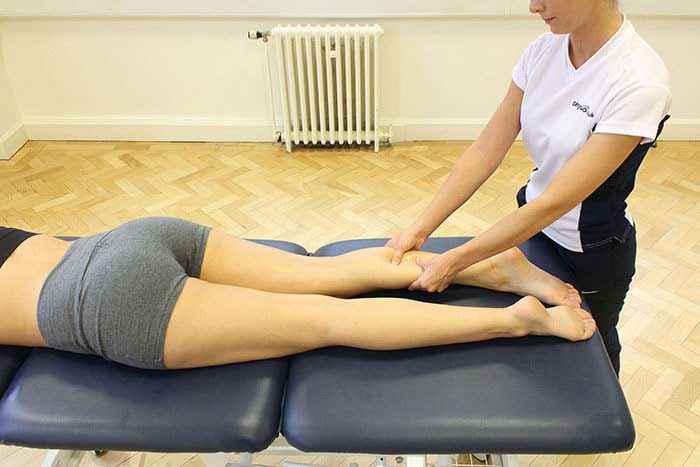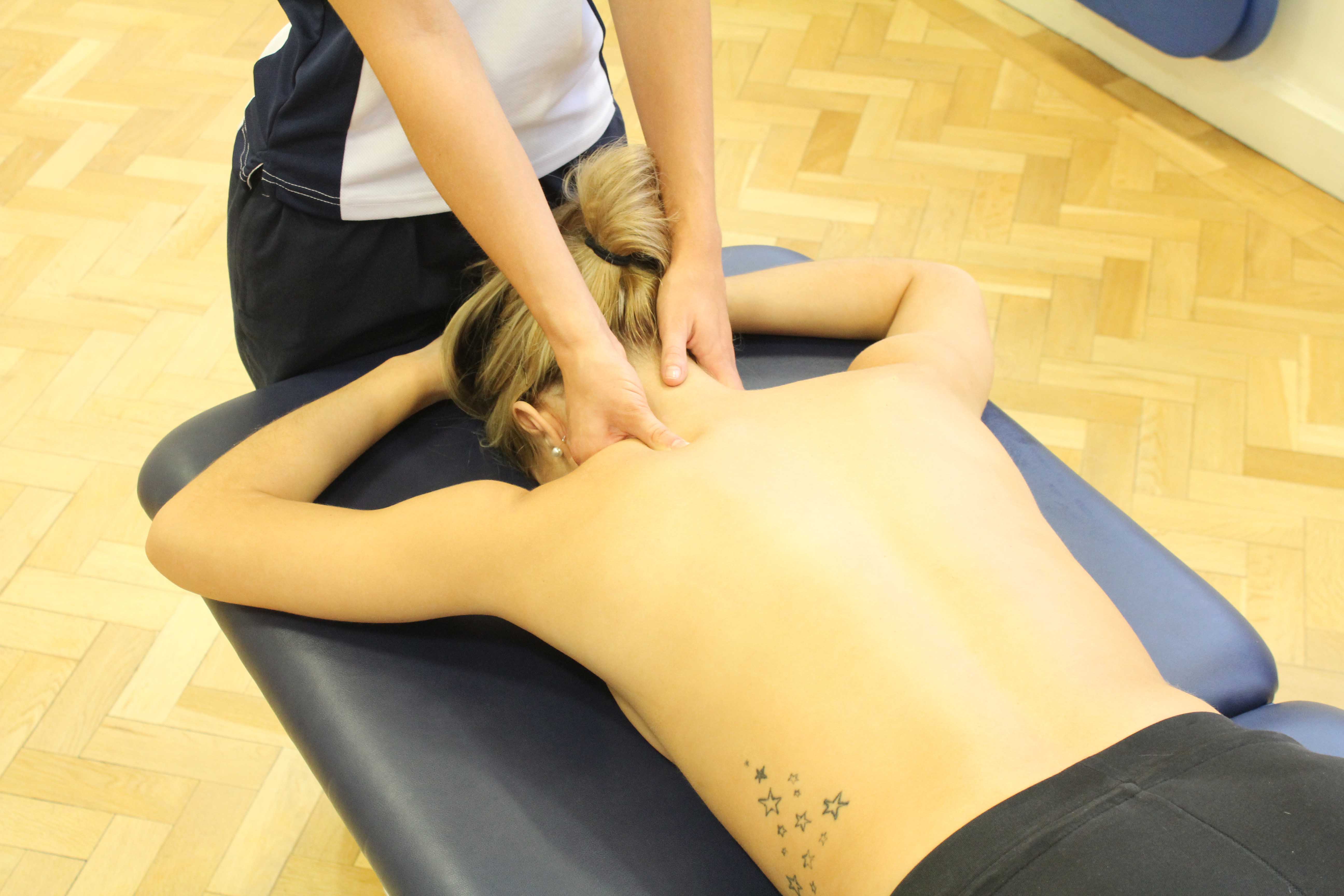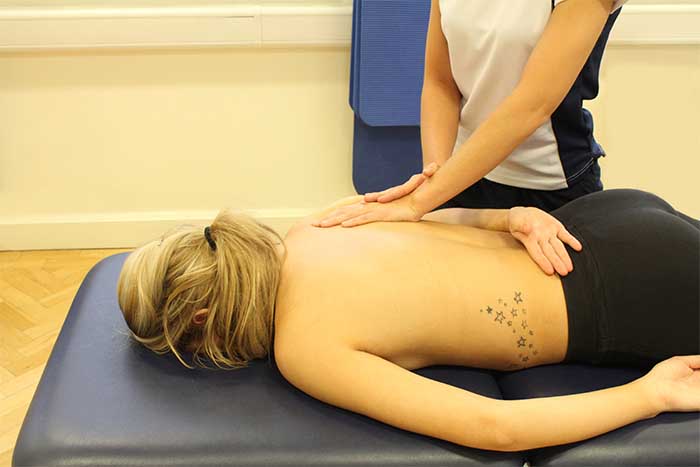At Physio.co.uk our massage therapists offer deep tissue massages to help treat pain, muscle tension, tightness and reduced range of movement. A deep tissue massage is applied to deeper layers of muscles and fascia tissue (connective tissue surrounding muscles). A deep tissue massage can be used to treat adhesions in muscles, breaking down hard fibrous tissue and realigning them back into normal form. A deep tissue massage will be beneficial to decrease tension increase flexibility, reduce pain and improve recovery.
What is a deep tissue massage?
A deep tissue massage is a type of massage that focuses on deeper layers of muscle and connective tissues. It is used to help realign tissues back into normal form. A deep tissue massage is used to help relief pain and stiffness. Deep tissue massage techniques are applied with deep pressure and at a slow rate to areas of tension and pain in order to reach deep muscles and fascia. Deep tissue massage works by physically breaking down hard areas of rigid tissue called adhesion and relieve pain. A deep tissue massage uses massage oils to relax muscles and then work into deeper musculature.

What techniques are used in a deep tissue massage?
At Physio.co.uk our massage therapists use a wide range of deep tissue massage techniques. These include:
 Above: Deep tissue massage on soleus muscle
Above: Deep tissue massage on soleus muscleThere are many massage techniques used in a deep tissue massage. Techniques which are used in a deep tissue massage are deep strokes, rolling, frictions, picking up and vibrations.
Deep strokes are an effective technique used in a deep tissue massage. Heavier pressure is required to affect deeper and underlying muscles. Deep strokes aim to promote relaxation in deep muscles and improve local circulation. Pressure applied on the tissue can help the removal of waste products, relieve pain and stiffness.
Rolling is used in a deep tissue massage to increase temperature, improve tissue elasticity, relieve tension and decrease pain. Rolling releases tension in the muscles particularly after participation in sport or after a workout. The rolling technique is effective to decrease pain by using rhythmically rocks until pain and tension is eased.
Frictions can be an effective part of a deep tissue massage. Frictions are localised manipulations performed transversely across muscle fibres. Frictions can be performed over ligaments and around joints to increase circulation, improve nourishment of ligament and improve joint function.
Picking up is a manipulation technique used in a deep tissue massage where tissues are lifted away from the bone, squeezed and released. Picking up is used as part of a deep tissue massage to increase blood circulation, ease tension and relieve pain. The manipulation of this technique also improves elasticity and extensibility of the tissues. Picking up stretches tight fascia and tight muscles and increases flexibility.
Vibrations are a particular technique used in a deep tissue massage. Vibrations are used to stimulate the lymphatic drainage in the body, relieve tension and aid relaxation. The vibration technique aids absorption of tissue fluid, it soothes superficial nerves which relieves tension and promotes relaxation.
 Above: Deep Tissue Shoulder Massage targetting trapezius muscle
Above: Deep Tissue Shoulder Massage targetting trapezius muscleWhen can a deep tissue massage help?
A deep tissue massage is an effective treatment used to help:
There are many occasions when a deep tissue massage can help. A deep tissue massage can help chronic pain, tight muscles, reduce high muscle tone and post injury.
Deep tissue massage can be used to help chronic pain. Pain can happen for a number of reasons. Chronic pain can be caused from numerous illnesses or injury. A deep tissue massage for chronic pain works by interrupting the cycle of chronic pain. When pain occurs, muscles tighten to protect an area. Mobility becomes limited and often blood circulation is reduced. Deep tissue massage can help loosen tight muscles by lengthening muscles. Deep tissue massage can also improve circulation by increasing blood flow and promote relaxation to reduce emotions such as stress and anxiety related to chronic pain.
A deep tissue massage can also be used to help treat tight muscles. Muscles can tighten due to soft tissue damage, increased tone and muscle contractures. The aim of a deep tissue massage is to release tension in the muscles and restore blood flow. Tight muscles can be reduced in blood circulation and restrict movement. Deep tissue massage can use a range of techniques to stimulate blood flow, loosen muscle fibres and restore movement.
Deep tissue massage can be used to treat high muscle tone. High muscle tone is tension in the muscle when at rest. High tone in the muscles comes from an increase in excitatory messages from the nervous system. Excitatory messages are released from the brain and travel down the spinal cord and into the nerves. The stimulation of nerves causes muscle tension and muscle tone to increase. Deep tissue massage can help reduce muscle tone by increasing temperature of soft tissues, increasing blood circulation and breaking down adhesions.
Deep tissue massage can also be used to treat post injury. Deep tissue massage can be used in the rehabilitation stage of an injury. Deep tissue massage helps post injury by increasing blood circulation to an affected area, stimulating the healing process, breaking down scar tissue and restoring range of movement. Scar tissue is formed as part of the healing process around an injury. Scar tissue can be hard and rigid causing limited movement. Deep tissue massages can breakdown scar tissue and help restore movement around an injury.

What are the physiological effects of a deep tissue massage?
A deep tissue massage produces a range of beneficial physiological effects: The physiological effects of a deep tissue massage include:
The physiological effects of a deep tissue massage are increased venous return, increased temperature, removal of waste products, increased cellular exchange and increased tissue elasticity.
A physiological effect of a deep tissue massage increases venous return. Pressure of the techniques applied during a deep tissue massage increases the flow of the venous and lymphatic systems. The increase in return of blood improves he arterial blood supply and fills cleared vessels. Blood is also rich with oxygen and growth, the effect of massage allows tissue condition to be improved.
Increased temperature is also a physiological effect of a deep tissue massage. Superficial friction increases localised heating to an area being massaged. Increased temperature relaxes the body both physically and psychologically. An increase of relaxation allows muscles to be mobilised and tissues elasticity to be increased.
A physiological effect of a deep tissue massage is the removal of waste products. Waste products can build up naturally in the muscle and is increased during exercise. A deep tissue massage helps to increase the metabolic rate. The metabolic rate is the rate of energy expenditure the body can produce. An increase of metabolic rate means a quicker removal of waste products in the muscles and a healthier condition of tissues.
Another physiological effect of a deep tissue massage is increased cellular exchange. Specific techniques increase blood circulation. Improved circulation can enhance the delivery of oxygen and nutrients to muscle cells. As cellular health improves, issues function more efficiently. More efficiently muscle lead to the removal of waste products and increase the absorption of excess fluids and reduce swelling in soft tissues.
Another physiological effect of deep tissue massage is increased tissue elasticity. Muscle tissue can easily become hard and inelastic. Hardening of tissues affects the metabolic rate in the muscles. By kneading soft tissues it can pull the elastic structures to near their maximal length in many directions. This is important to maintain normal elasticity in the tissues as they are continually put under pressure and stress in certain positions.
What are the benefits of a deep tissue massage?
Deep tissue massage has many benefits. The benefits of a deep tissue massage include:
The benefits of a deep tissue massage are decreased tension, reduced pain, increased flexibility and improved recovery.
One benefit of a deep tissue massage is decreased tension. Tension is the state in which the muscles are semi-contracted for a period of time. An increase of muscle tension can cause stiffness, pain and restricted movement. A deep tissue massage can be an effective treatment to relieve tension. A deep tissue massage helps by increasing temperature of the soft tissues, reducing pain, increasing psychological relaxation and increasing tissue elasticity.
A deep tissue massage can also be beneficial to reduce pain. Pain can occur for a variety of reasons. A deep tissue massage helps by releasing pain relief hormones, reducing tension, and interrupting pain signals to the brain. A deep tissue massage helps by affecting the central nervous system. It causes the release of endorphins which abolish pain sensations in the brain. It also helps by stimulating mechanoreceptors in the body that help reduce muscle tensions, spasms and reduce pain. Massage stimulates the pain gate theory which prevents pain impulses going beyond the spinal cord and into the brain. Perception of pain is modulated by other signals travelling to the brain.
Deep tissue massage is an effective and beneficial massage type to increase flexibility. Excessive repetition or particular long standing of static muscle movements makes tissues hard and inelastic. Hard tissues cause metabolism to suffer. Metabolism is the rate of energy expenditure in the body. In muscles the metabolism rate refers to the rate in which waste products can be removed out and oxygen and nutrients are delivered in. A deep tissue massage technique like kneading can help pull elastic structures to their near maximal length in all directions. This is important to maintain normal elasticity in tissues which are continually put under pressure.
Deep tissue massages can also be a benefit to helping improve recovery. A deep tissue massage can be an essential part of the recovery process. Massage such as deep tissue massages can also help people participating in sport to train more efficiently and prevent injuries from occurring. A deep tissue massage is beneficial to improve recovery, post exercise, as part of a training programme or after injury. A deep tissue massage helps to encourage healing of soft tissues in the body after injury. Massage can improve blood circulation and encourage oxygen and nutrients to repair damaged cells. A deep tissue massage also aids pain relief so that injuries can be rehabilitated back to normal form.
Summary
A deep tissue massage is a type of massage that focuses on deeper layers of muscle and connective tissues. A deep tissue massage can be beneficial to treat both sport related and non-sport related muscular conditions. Techniques which are used in a deep tissue massage are deep strokes, compression, frictions, picking up and vibrations. A deep tissue massage has many benefits. The benefits of a deep tissue include decreasing tension, reducing pain, increasing flexibility and improving recovery. Receiving a deep tissue massage can produce effective physiological benefits that include increased venous return, increased temperature, removal of waste products, increased cellular exchange and increased tissue elasticity. Massage therapists at Physio.co.uk are highly experienced in deep tissue massage. Our massage therapists will perform a deep tissue massage suitable to your treatment goals.
To arrange a deep tissue massage at Physio.co.uk please e-mail us at office@physio.co.uk or call us on 0800 033 7800.
How can I arrange a deep tissue massage?
The easiest way to arrange a deep tissue at Physio.co.uk is to email us at office@physio.co.uk or call us on 0800 033 7800.
Alternatively if you have any questions please feel free to contact us.
We offer a 7 day service and provide home and clinic appointments.

 0330 088 7800
0330 088 7800


































